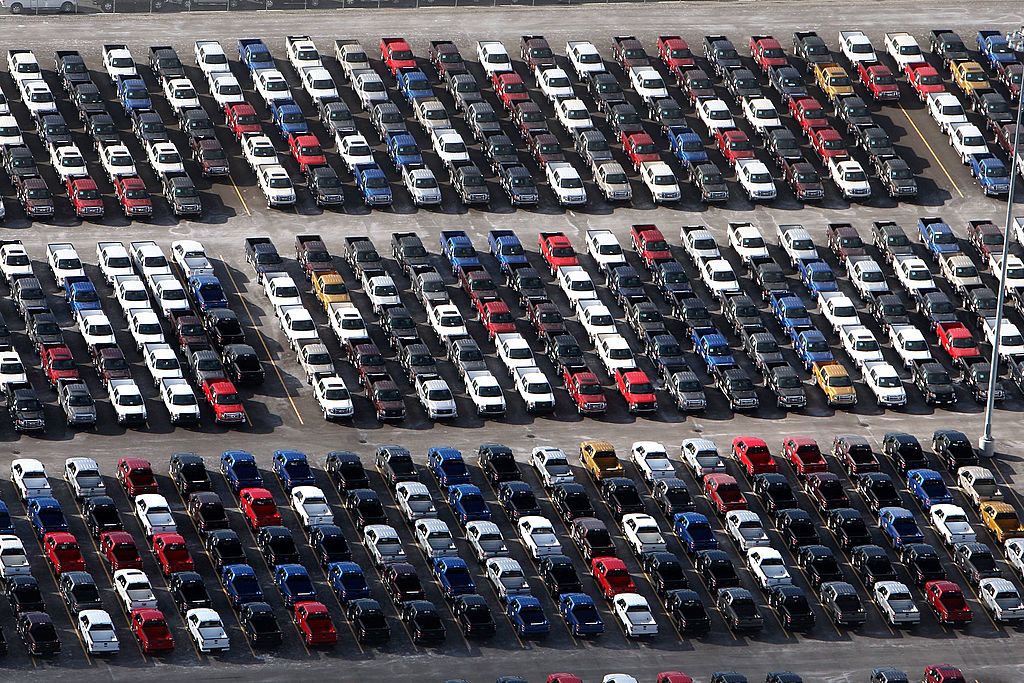BUSINESS NEWS
Edmunds warns of a tough 2019 for US auto industry as sales slide
[ad_1]
Ford trucks parked in a lot in 2008 when U.S. automakers were hit by plummeting auto sales.
Spencer Platt | Getty Images
U.S. auto sales are estimated to have fallen by about 2% during the first half of the year, setting the industry up for its second year-over-year decline since emerging from the Great Recession nearly a decade ago, two new studies warn.
How much deeper the downturn will go is a matter of debate, as is the timing of a market recovery, according to researchers from both the AlixPartners consultancy and auto data firm Edmunds. But even the modest decline predicted over the next three or so years, the studies agree, will strain the resources of automakers who have seen costs rising, even as sales and revenues slow.
“Automakers are fighting a war on multiple fronts right now,” said Jeremy Acevedo, manager of industry analysis for Edmunds, which released it’s mid-year forecast Wednesday. “Old cars are piling up on dealer lots, a glut of affordable off-lease vehicles are luring shoppers into the used market, and even with the Fed set to lower rates in July, higher interest rates are here to stay.”
All-time record
The U.S. auto market hit an all-time record for new cars, with 17.5 million in sales in 2015. Sales the following year were flat, then dipped to 17.2 million in 2017 and rebounded in 2018, rising to 17.3 million. But the first half of this year has plunged into negative territory. Edmunds anticipates sales for all of 2019 will drop to 16.9 million. That’s the same estimate from AlixPartners, which is forecasting a further dip to 16.3 million in 2020 and just 15.1 million in 2021.
The strong economy, low unemployment and solid consumer confidence numbers have helped the industry avoid the sort of freefall seen during the last recession, according to Edmunds’ mid-year analysis. But they can only go so far, and there are already signs of trouble, added Acevedo’s colleague Jessica Caldwell, Edmunds’ executive director of industry analysis.
Retail auto sales slipping
Retail sales, to consumers, have actually been slipping since mid-decade, according to industry data.
“Automakers have been relying on fleet (sales) more than in the recent past,” said Caldwell, cautioning that the number of vehicles that can be pushed into daily rental and other fleet markets may be reaching saturation.
There are other signs of trouble, including the fact that several utility vehicle segments have begun to flatten and even decline, including compact crossovers. At the same time, demand for sedans and other passenger cars continue to slide rapidly.
One concern is that many potential new vehicle buyers are being priced out of the market. The average transaction price — what customers pay after in incentives and accessories are factored in — is at an all-time high $37,000, according to Edmunds, even as interest rates have forced buyers to stretch out loans.
Sales incentives rise
Incentives have been on the rise, though not as aggressively as a decade ago, said Caldwell. One reason is that financing costs have made it more difficult for manufacturers to offer the zero-interest loans that helped buoy demand coming out of the recession.
Many buyers are looking for alternatives, she added, noting “the used market has never been a more attractive prospect for many people.”
In particular, automakers are pushing certified pre-owned vehicles, which are relatively recent models with warranties similar to new cars but at substantially lower sticker prices. A reasonably equipped, low-mileage 2016 BMW 3-Series, Caldwell said, may go for $20,000, roughly half the $40,250 base sticker for a 2019 sedan.
A glut of off-lease vehicles will hit the market this year, according to Edmunds, further straining demand for new vehicles.
Pressure on the industry
The pressure on the industry is coming at a particularly tough time, according to Mark Wakefield, the head of the automotive practice at AlixPartners. They’re not only having to cover traditional product development and manufacturing costs, but also must sink money into research and development related to two emerging technologies: autonomous and electrified vehicles, he said.
Automakers globally will see annual investments in self-driving vehicles grow to $85 billion by 2025, said Wakefield, while the industry is expected to invest a collective $225 billion in battery-car technology between 2019 and 2023.
That is rapidly driving up break-even costs. In the U.S., automakers needed to see an industry sales total of just 10 million vehicles to stay in the black in 2010, according to the suburban Detroit-based consultancy. That rose to 13.5 million by 2015 and hit 15.0 million by 2018.
Reasonable discipline
Automakers have maintained a “reasonable amount of discipline,” Wakefield said, avoiding the sort of freewheeling spending on incentives and new factories seen prior to the Great Recession.
They are also shifting strategies when it comes to the development of the new technologies that are expected to reshape the automobile in the years to come. BMW and Jaguar Land Rover, for example, have teamed up on the development of electrified vehicles, while Honda and General Motors are sharing autonomous vehicle development efforts.
Wakefield said he wouldn’t be surprised to see automakers also consider more mergers like the ultimately unsuccessful one that Fiat Chrysler proposed with French manufacturer Renault.
Both the Edmunds and AlixPartners studies anticipate growth in the battery-car market over the next few years, but see those vehicles remain a niche through at least mid-decade, and one that will likely do little to offset development and manufacturing costs anytime soon.
[ad_2]
Source link









